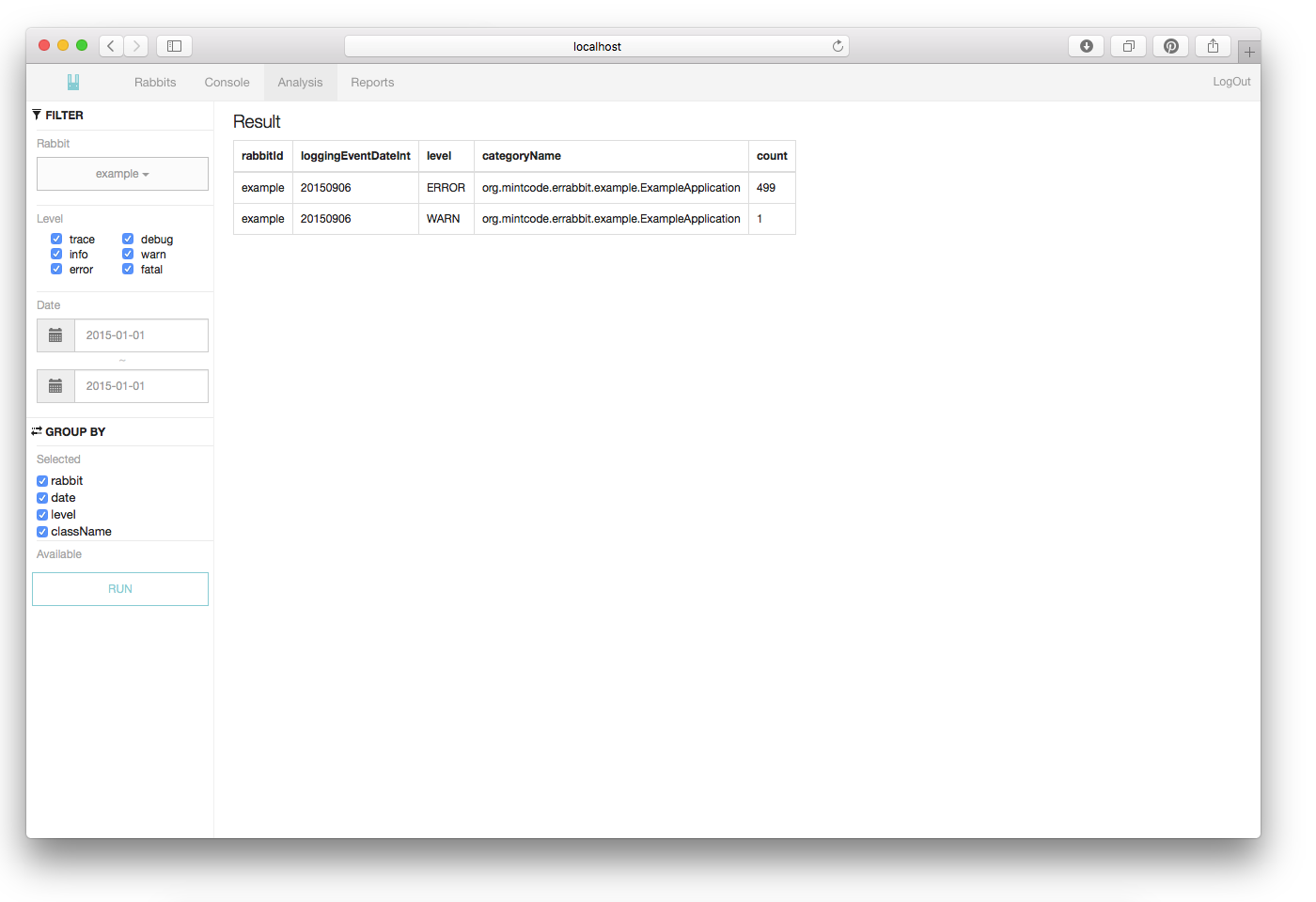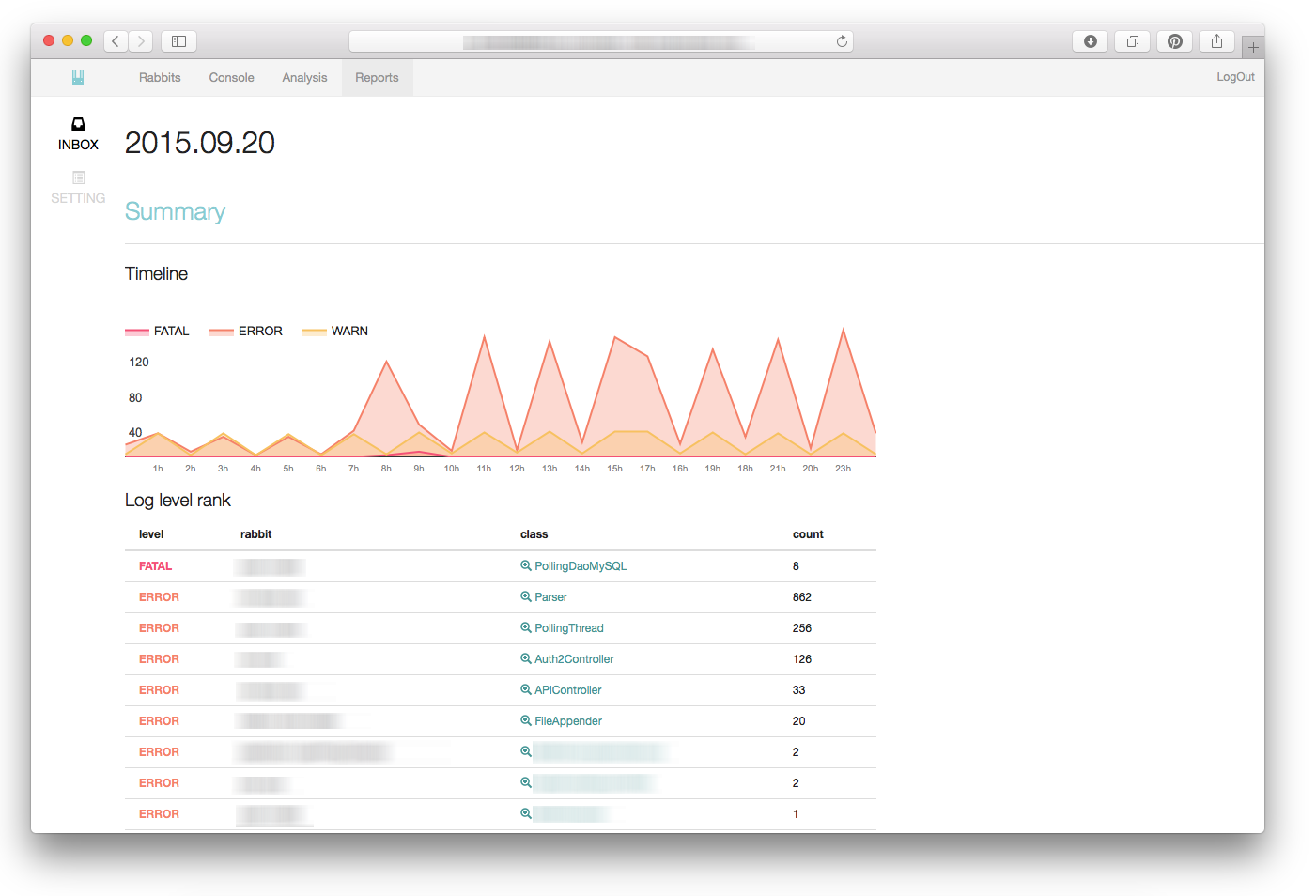ErRabbit(Error Rabbit) is useful error remote tracking service with Visual View. Collecting by Log4j and ActiveMQ will make it easy compatible with other programs.
Introduction Slide http://www.slideshare.net/ilhoahn50/errabbit
- RrRabbit aim to visualize Error logs
- Easy to integrate on exisiting java application.
한국어 설명은 이곳에 있습니다.
- Managing rabbits(your applications)
- Grouping
- Clean logs
- View logs
- Explorer logs selected day
- Log level chart by time
- Filtering logs by level or class name
- View Exception trace with graphical flow chart
- Show or hide library packages
- View original text log
- Search library package info with google search
- Live feed all logs with WebSocket
- Same log view functions like log view page
- Easy ggregating logs counts with custom grouping and filtering
- Daily report batch
- View all yesterday event logs on one page.
- Java 1.7 upper
- MongoDB 2
- ActiveMQ
- Configure Log4j
- Run MongoDB, ActiveMQ
- Run ErRabbit
- Make a Rabbit
- Add JMS Appender to your application log4j2.xml
https://github.com/soleaf/ErRabbit/releases
ErRabbit uses MongoDB and ActiveMQ.
- Run MongoDB
- ActiveMQ server
- Edit
settings.properties - For MongoDB and ActiveMQ.. etc Set with your sever settings.
Run with command sh run.sh
Or directly command java -jar [war filename] --spring.config.location=file:settings.properties
- Connect Console with WebBrowser
http://localhost:[port] - Your server port is 'server.port' on 'settings.properties' and login account is also on properties ('errabbit.security.admin.username, errabbit.security.admin.password').
- Click 'add' menu on left side.
- Make your new rabbit. (Rabbit is a namespace for tracking log like application artifact id).
Choose method by your application log4j version.
- Log4j 1.2
- Log4j 2.x
Because Default JMS Appender on Log4j1 did not support queue, ErRabbit made a custom appender. There is dependency for our custom appender.
<dependency>
<groupId>org.mintcode.errabbit</groupId>
<artifactId>log4j-apeender</artifactId>
<version>1.0.0</version>
</dependency>- Declare 'errabbit' appender to
log4j.xmlwith your ActiveMQ URL, userName, password, rabbitID
<?xml version="1.0" encoding="UTF-8"?>
<!DOCTYPE log4j:configuration SYSTEM "log4j.dtd">
<log4j:configuration xmlns:log4j="http://jakarta.apache.org/log4j/">
<!-- Console view -->
<appender name="console" class="org.apache.log4j.ConsoleAppender">
<layout class="org.apache.log4j.PatternLayout">
<param name="ConversionPattern" value="%d [%t] %p - %C{1}.%M(%L) | %m%n"/>
</layout>
</appender>
<appender name="errabbit" class="org.mintcode.errabbit.log4j.Log4jAppender">
<param name="host" value="tcp://localhost:61616"/>
<param name="rabbitID" value="example"/>
<layout class="org.apache.log4j.PatternLayout">
<param name="ConversionPattern" value="%5p [%d{HH:mm:ss}] %m%n"/>
</layout>
</appender>
<logger name="org.mintcode.errabbit.example">
<level value="ERROR"/>
<appender-ref ref="errabbit"/>
</logger>
<!-- Root Logger -->
<root>
<priority value="INFO" />
<appender-ref ref="console" />
</root>
</log4j:configuration>CustomAppender's source : https://github.com/soleaf/ErRabbit-log4j-apeender
You can collect all kind of log(info, debug, trace .. etc). But, for your application performance, use only as exception error logging.
- Get Log4j Logger
Logger logger = Logger.getLogger(getClass());- Log error with exception, Just type
logger.error([message],e). Another log level is same as your before code(like logger.info("hello");).
try{
int a[] = new int[2];
System.out.println("Access element three :" + a[3]);
}
catch (Exception e){
logger.error(e.getMessage(),e);
}Example Project : https://github.com/soleaf/ErRabbit-Example-log4j1
<dependency>
<groupId>javax.jms</groupId>
<artifactId>jms</artifactId>
<version>1.1</version>
</dependency>
<dependency>
<groupId>org.apache.activemq</groupId>
<artifactId>activemq-core</artifactId>
<version>5.7.0</version>
</dependency>and add repository for javax.jms (if maven can't find javax.jms)
<repositories>
<repository>
<id>repository.jboss.org-public</id>
<name>JBoss.org Maven repository</name>
<url>https://repository.jboss.org/nexus/content/groups/public</url>
</repository>
</repositories>- Declare 'JMS Appender' to
log4j2.xmlwith your ActiveMQ URL, userName, password. - 'queueBindingName' should be 'errabbit'.
- And add JMS Appender to Loggers.
<?xml version="1.0" encoding="UTF-8"?>
<Configuration status="info" name="MyApp" packages="org.mintcode.errabbit.example">
<Appenders>
<JMS name="errabbit"
queueBindingName="errabbit.report.example"
factoryBindingName="ConnectionFactory"
providerURL = "tcp://localhost:61616"
userName = "sender"
password = "senderpassword!"
/>
<Console name="STDOUT" target="SYSTEM_OUT">
<PatternLayout pattern="%m%n"/>
</Console>
</Appenders>
<Loggers>
<Logger name="org.mintcode.errabbit.example" level="error">
<AppenderRef ref="errabbit"/>
</Logger>
<Root level="error">
<AppenderRef ref="STDOUT"/>
</Root>
</Loggers>
</Configuration>
- Make
java/main/resource/jndi.properties, and put same ActiveMQ settings(username, password, rabbitID). - queue.errabbit's value should be 'errabbit.report.[RabbitID]'.
java.naming.factory.initial = org.apache.activemq.jndi.ActiveMQInitialContextFactory
java.naming.provider.url = tcp://localhost:61616
queue.errabbit = errabbit.report.example
ErRabbit uses Log4j2 JMS Appender, and collects exceptions with other information logs. You can collect all kind of log(info, debug, trace .. etc). But, for your application performance, use only as exception error logging.
- Get Log4j Logger
Logger logger = LogManager.getLogger(getClass());- Log error with exception, Just type
logger.error([message],e)
try{
int a[] = new int[2];
System.out.println("Access element three :" + a[3]);
}
catch (Exception e){
logger.error(e.getMessage(),e);
}Example Project : https://github.com/soleaf/ErRabbit-Example-log4j2
We welcome anyone want to improve ErRabbit.
- You can just fix and send pull request to me.
- Or talk about new feature through email([email protected]).
- Please comment as English at commit.
Please read this wiki
https://github.com/soleaf/ErRabbit/wiki
- :D 신현묵(Twitter @zetlos, [email protected])
- Golden prize at 2015 OSS world challenge
- Always ok! [email protected]
Apache 2.0 (http://www.apache.org/licenses/LICENSE-2.0)







